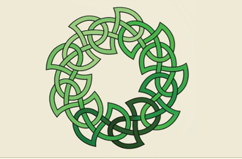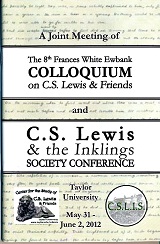Event Title
Academic Paper Session 4-A
Location
Rupp 203
Start Date
2-6-2012 9:30 AM
Description
"A Speculative Meditation on Tolkien's Sources for the Character Gollum" - Woody & Susan Wendling
In speaking of his sources for ents, Tolkien said they "are composed of philology, literature, and life." Was Gollum composed in the same way? Gollum got his start in Tolkien's writings as a creature in his poem "Glip." Gollum got his name from his "gurgling sound," the "horrible swallowing noise in his throat." From which literary sources did Tolkien arrive at the name Gollum? From the Old Norse word for gold, gollum? From the Jewish Golem (Psalm 139:16)? From the giant Goliath in the Old Testament? From Gorbo or Golithos, two characters in E.A. Wyke-Smith's book, "The Marvellous Land of Snergs?" Or from the "Gollywogg" books by the Upton sisters? Tolkien wrote of his creative process, "Nevertheless one's mind is, of course, stored with a 'leaf mould' of memories (submerged) of names, and these rise up to the surface at times, and may provide with modification the bases of 'invented' names." Two more definite sources for Gollum are the monster Grendel in "Beowulf" and the Christian Gospel, as expressed by the frequent appeals for mercy in the Roman Catholic mass.
"Aragorn and Arther, Merlin and Gandalf: Tolkien's Transmogrification of the Arthurian Tradition and Its Use as a Palimpsest for The Hobbit and The Lord of the Rings" - Mark R. Hall
Certainly J.R.R. Tolkien was very much aware of the Arthurian tradition that existed during the medieval period and even earlier, especially as depicted by Thomas Mallory in Le Morte d'Arthur. The affinities of the characters of Aragorn and Gandalf with Arthur and Merlin are too obvious not to notice, yet transformed in such a way by Tolkien that they are infused with new meaning and purpose. It is this transmogrification that connects Tolkien's work with the past and provides the palimpsest for the world he creates in his epic adventure depicted in The Hobbit and The Lord of the Rings. An examination of the specific details of this process enlightens the readers, and enlivens and exfoliates the text.
"Tom Bombadil and Treebeard: The Adaptation of Medieval Concepts of Nature in J.R.R. Tolkien's The Lord of the RIngs" - Dawn Martin
J.R.R. Tolkien imbued his tales of Middle Earth with his love of nature and all things medieval. In doing so, three specific medieval concepts of nature are present, which thoughtfully fashion the characters of Treebeard and Tom Bombadil. Instead of using allegory, Tolkien uses personification to adapt the medieval concept of nature mythology. Tom Bombadil and Treebeard are not an attempt to explain nature; they are nature personified. Likewise, the Green Man concept of nature emphasizes the importance of communing with nature, from which all life emerges and is sustained. While Treebeard physically exhibits the quality of the Green Man, Tom Bombadil's spiritual kinship with the landscape makes him a part of nature as well as master of it. Therefore, the classic opposition of good and evil, as represented through the natural and unnatural, suffers an easy synthesis with the first two concepts. Both Tom Bombadil and Treebeard are forces for good because they are nature personified communing with the natural world, and their enemies are dark, distorted abusers of the natural order and, therefore, evil. The identification and association of these three concepts of nature with the characters of Tom Bombadil and Treebeard offer a fresh perspective on the marriage of Tolkien's love for natural history with medieval concepts of nature.
Event Type
Paper
Link to Papers
A Speculative Meditation on Tolkien's Sources for the Character Gollum
Tom Bombadil and Treebeard: The Adaptation of Medieval Concepts of Nature in J.R.R. Tolkien's The Lord of the RIngs (Not available)
Academic Paper Session 4-A
Rupp 203
"A Speculative Meditation on Tolkien's Sources for the Character Gollum" - Woody & Susan Wendling
In speaking of his sources for ents, Tolkien said they "are composed of philology, literature, and life." Was Gollum composed in the same way? Gollum got his start in Tolkien's writings as a creature in his poem "Glip." Gollum got his name from his "gurgling sound," the "horrible swallowing noise in his throat." From which literary sources did Tolkien arrive at the name Gollum? From the Old Norse word for gold, gollum? From the Jewish Golem (Psalm 139:16)? From the giant Goliath in the Old Testament? From Gorbo or Golithos, two characters in E.A. Wyke-Smith's book, "The Marvellous Land of Snergs?" Or from the "Gollywogg" books by the Upton sisters? Tolkien wrote of his creative process, "Nevertheless one's mind is, of course, stored with a 'leaf mould' of memories (submerged) of names, and these rise up to the surface at times, and may provide with modification the bases of 'invented' names." Two more definite sources for Gollum are the monster Grendel in "Beowulf" and the Christian Gospel, as expressed by the frequent appeals for mercy in the Roman Catholic mass.
"Aragorn and Arther, Merlin and Gandalf: Tolkien's Transmogrification of the Arthurian Tradition and Its Use as a Palimpsest for The Hobbit and The Lord of the Rings" - Mark R. Hall
Certainly J.R.R. Tolkien was very much aware of the Arthurian tradition that existed during the medieval period and even earlier, especially as depicted by Thomas Mallory in Le Morte d'Arthur. The affinities of the characters of Aragorn and Gandalf with Arthur and Merlin are too obvious not to notice, yet transformed in such a way by Tolkien that they are infused with new meaning and purpose. It is this transmogrification that connects Tolkien's work with the past and provides the palimpsest for the world he creates in his epic adventure depicted in The Hobbit and The Lord of the Rings. An examination of the specific details of this process enlightens the readers, and enlivens and exfoliates the text.
"Tom Bombadil and Treebeard: The Adaptation of Medieval Concepts of Nature in J.R.R. Tolkien's The Lord of the RIngs" - Dawn Martin
J.R.R. Tolkien imbued his tales of Middle Earth with his love of nature and all things medieval. In doing so, three specific medieval concepts of nature are present, which thoughtfully fashion the characters of Treebeard and Tom Bombadil. Instead of using allegory, Tolkien uses personification to adapt the medieval concept of nature mythology. Tom Bombadil and Treebeard are not an attempt to explain nature; they are nature personified. Likewise, the Green Man concept of nature emphasizes the importance of communing with nature, from which all life emerges and is sustained. While Treebeard physically exhibits the quality of the Green Man, Tom Bombadil's spiritual kinship with the landscape makes him a part of nature as well as master of it. Therefore, the classic opposition of good and evil, as represented through the natural and unnatural, suffers an easy synthesis with the first two concepts. Both Tom Bombadil and Treebeard are forces for good because they are nature personified communing with the natural world, and their enemies are dark, distorted abusers of the natural order and, therefore, evil. The identification and association of these three concepts of nature with the characters of Tom Bombadil and Treebeard offer a fresh perspective on the marriage of Tolkien's love for natural history with medieval concepts of nature.


